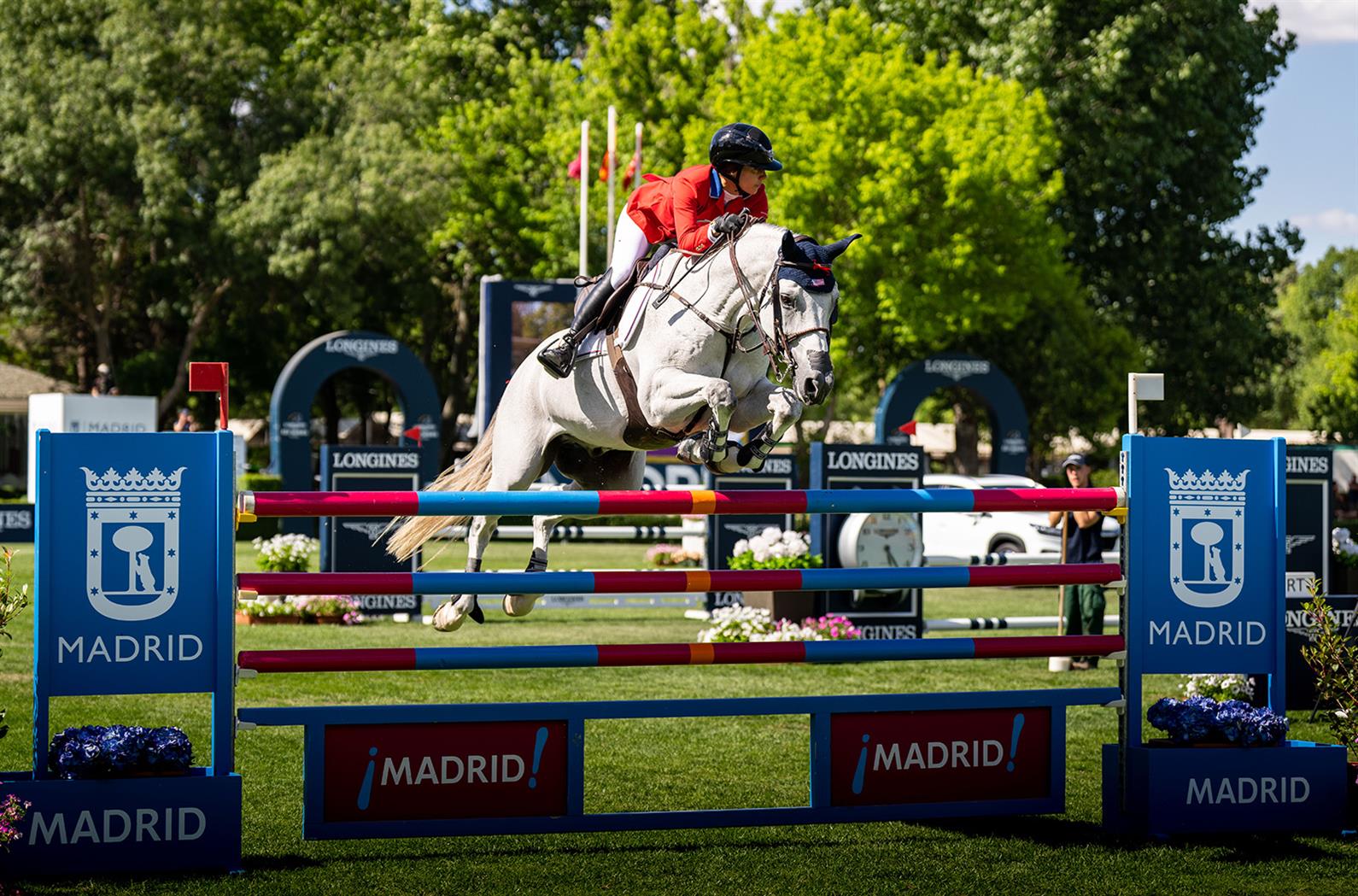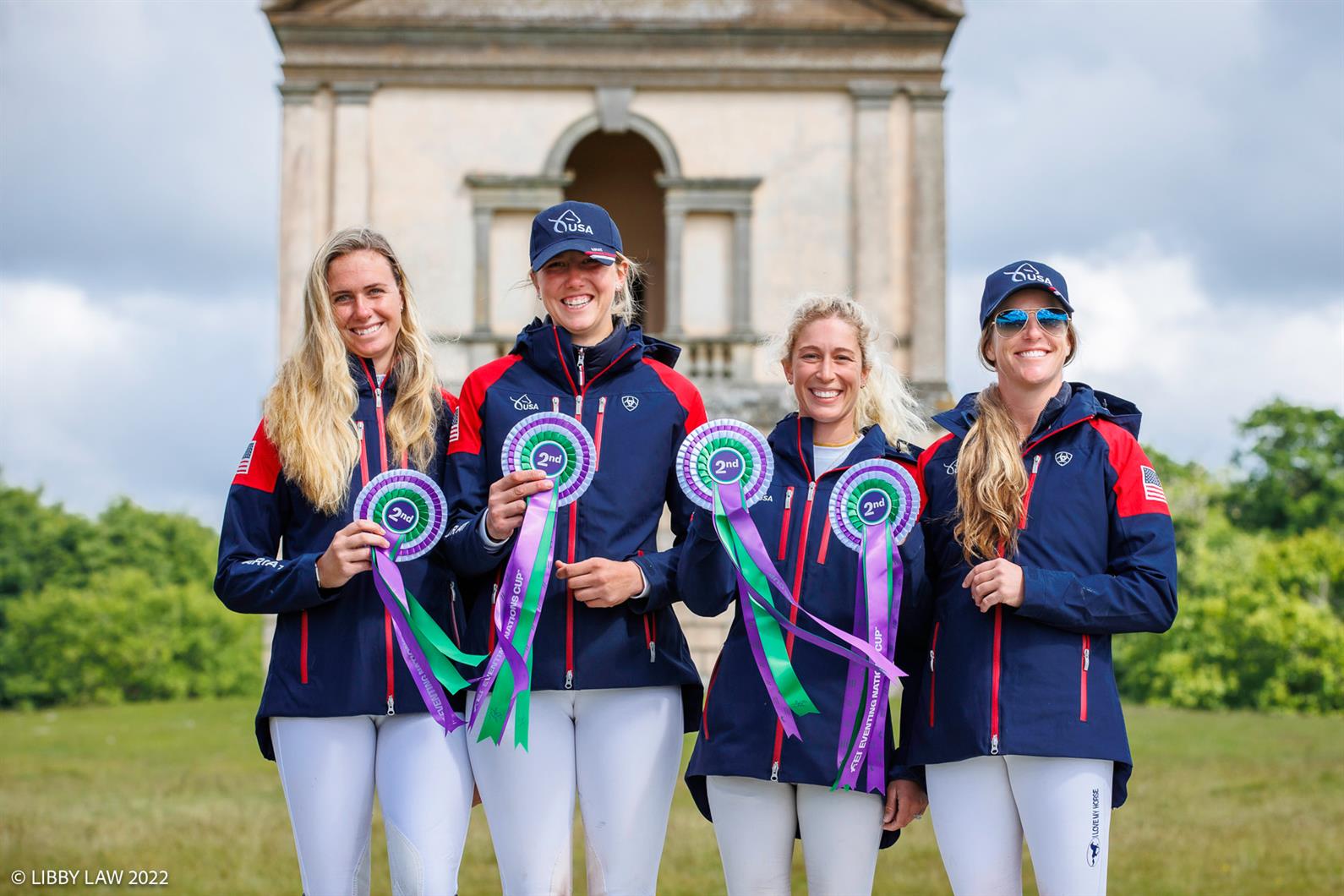For athletes with aspirations to compete at the elite level, there is a long path from competing at the national level to representing the U.S. at international championships. The USEF development pathways for each FEI discipline help bring promising athletes along each step of the way, ensuring the best chance at success.

In spring of 2022, developing teams in eventing and jumping both had important outings in Europe. On the jumping side, a team of young athletes competed at CSIO3* FEI Jumping Nations Cups in Lisbon, Portugal, and Madrid, Spain. At the same time, a team represented the U.S. at the FEI Eventing Nations Cup Great Britain CCIO4*-S at Houghton Hall Horse Trials and came home with a second-place finish.
U.S. Eventing Development and Emerging Coach Leslie Law and U.S. Jumping Development Coach Anne Kursinski shared their insights into their respective sports’ pathways and how outings like these are essential to the country’s future success at equestrian sport’s biggest events.
Selecting the Teams
Athletes submit an application to be considered for a team. For Houghton Hall, three of the four team members were already in Europe, Law explains. Isabelle Bosley and Caroline Martin had both gone over earlier in the spring for a developing program European tour. Cornelia Dorr is based with British athlete Kevin McNabb this year. The fourth team member, Allie Knowles, traveled over from her home base in Kentucky. Martin had previous Nations Cup experience, but the other three were first-timers for this level of team competition.
“The selectors had a meeting and agreed that those four should go and participate and make up a team for the U.S.,” said Law. “I think it’s very important that we do put these younger athletes in this space to get team experience. There’s isn’t a huge opportunity for that over here [in North America], and I think the more we can give them that kind of experience and see how they perform in that space is very important. It’s important for them, and I think it’s important for selectors.”
Kursinski’s jumping team for Lisbon and Madrid was comprised of Rebecca Conway, Daisy Farish, Charlotte Jacobs, Alex Matz, and Julie Welles. Most of the athletes had competed as part of a team at the North American Youth Championships (NAYC) earlier in their career, but these events offered a first experience on a senior FEI Nations Cup for all of them.
“All of these riders really earn their way onto those teams [through a selection process],” said Kursinski. “They’re all very competitive and they’ve all been successful at grands prix, but they’d never jumped on a 3* Nations Cup team, so to really get this team experience was wonderful for them.”
The Team Experience
“You can talk about it all you want. You can watch all you want. But putting on that pinque coat and representing your country, it’s different,” said Kursinski. “To step into the ring and do it, to ride as a teammate…I thought it was just a wonderful experience for all of them.”
In addition to the novelty of competing as a team, the two-round format of a Nations Cup is its own unique experience for the jumping athletes.
“Lisbon is always extremely difficult because the second round of the Nations Cup is under the lights,” said Kursinski. “We all knew that going in and explained it to everybody, but until you experience it, it can be very different under the lights. It was a great experience for everybody that way.”
Being part of a team goes beyond what happens in the ring or on course, and the coaches see how the athletes perform as team players in all aspects of the experience.
“It was great having them all together and seeing their camaraderie,” said Kursinski. “Julie Welles was the alternate the second week, and she was fabulous on the ground and helping out with the other riders at Madrid. She was so part of the team. As I was up at the ring watching, she was helping with some of the riders and really being a team player. That kind of experience is what they need. You need it before you ever get to a Pan Am Games or the Olympics or a championship.”

“When you’re on a team, you do have the feeling that you’re not just riding for yourself,” said Law. “This creates an added pressure and added responsibility, and in some athletes, that does affect performance in the beginning. But through experiencing it and becoming more confident within that space, you learn to perform in that area.”
For Law, maximizing a team’s chance at a successful result means knowing each individual combination’s strengths and weaknesses and making choices for the team accordingly.
“The first person that goes out, you’re looking for a good cross-country, and you’re looking for that rider to come back and be able to relay some good information to the team manager or chef,” Law said. “They can then use that information for the remaining three riders. I think the number one role is quite an important one, because they’ve got to be able to come back and give that kind of information to you. And then the fourth position is a very important role as the anchor depending on how the competition has unfolded.
“I put Cornelia to go first. Her horse (Daytona Beach 8) is a very good jumping horse, but does get a little tense in the dressage,” Law explained. “So for me, they were a good choice to go in number one so that we could hopefully have a good cross-country performance for the first combination going out. I had Isabel going second since it was her first time on a team, and Allie Knowles ran third since she has a little bit more experience. Caroline has ridden in a Nations Cup before, and that experience starts to count as the anchor of the team. And then you see how they operate.”
A Place on the Pathway
While any Nations Cup competition is a prestigious event in its own right, these early team events are an essential part of the preparation for competitions at the championship level.
“I’m a true believer that we’ve got to get athletes in that space,” said Law. “If we don’t do it, we’re not going to learn from it. I think we have to remember that there are going to be mistakes, especially with younger athletes. If there are going to be mistakes, that is the place for them. Let’s find out what they are and how we can improve them. Because we don’t want those mistakes at a Pan Ams or World Championships when you’re trying to qualify for an Olympic Games. And we certainly don’t want them at the Olympic Games where we’re trying to win medals.”
The team’s second-place finish at Houghton Hall was worth celebrating, and it positions the program and the athletes well for the long-term future of the U.S. on the world stage.
“It’s a milestone for our younger athletes coming through who will hopefully step up and compete for the U.S. at an Olympic Games or World Championship,” said Law. “They won’t be at the World Championships this year, but if they have the horsepower, could they be at Paris (for the 2024 Olympics)? Maybe. For those athletes, we’re probably looking more at the next World Championship and the Olympic Games in Los Angeles (in 2028).”
Simply getting overseas to compete against European teams is an essential component of developing competitive team athletes.
“It’s great, the depth we have,” Kursinski said of the up-and-coming jumping talent in the U.S. “But we don’t have international experience like the Europeans that start out with juniors and ponies in international team competitions. For us, getting these riders to qualify [for NAYC] and getting that team experience under their belt is so important.”
For the jumping development pathway, Kursinski’s role falls in between Youth Chef d’Equipe DiAnn Langer and Senior Chef d’Equipe Robert Ridland. The three of them communicate with each other when it comes to building teams.
“Robert will look to me for getting riders for his five-star teams that have been on teams before,” said Kursinski, pointing to Brian Moggre and Jessica Springsteen as recent examples of athletes who competed at NAYC and youth Nations Cup teams before being tapped for senior championship teams.
“The pathway really does work,” said Kursinski. “On occasion, somebody might have a brilliant horse and not have done the Young Riders. But it’s really hard to say, ‘Okay, we’re going to put you on a five-star team’ if you haven’t done a three-star. It’s just a different kind of pressure.”
Synergy Between the Sports
U.S. eventing has continued to refine its pathway in recent years, and jumping has served as a model to follow.
“I think our pathway is pretty solidified,” said Kursinski. “When I did it years ago, there was no pathway. You went to the horse show and got selected, if you were lucky. But now it starts in the Zones, getting on your Zone team to go to the NAYC. And then we’ve had the FEI Youth Nations Cup Final in Europe for the last several years, which has been great where even riders at that young age are really representing their country. So that’s kind of the carrot—go to the NAYC and if you’re good, you might get selected to go to the Youth Nations Cup Finals. The next thing is the three-stars, and from there, Robert will put some of those riders [on five-star Nations Cup teams.]”
Kursinski said that there is plenty of interest from jumping athletes who want to be considered for a three-star Nations Cup team, and the jumping discipline managers at US Equestrian are always working to secure invitations for more of these competitions to give as many qualified athletes as possible a chance to compete for the team.

On the eventing side, there simply aren’t as many team events on the FEI calendar, but Law is a big believer in getting to those competitions whenever possible.
“I don’t think it’s an accident that U.S. jumping is as successful as it is,” said Law. “A lot of them are in Europe all summer and doing Nations Cups over there. They’re taking themselves to the rest of the world. There are a lot of components [to jumping’s success], but I think one of the big components is that they’re over there competing in teams and those athletes are getting the experience in that space before they have to step up and do it in a senior championship. That’s why I am keen to do it [bring younger teams to compete at European Nations Cups] because I know they’re doing it in jumping, and they get results.”


